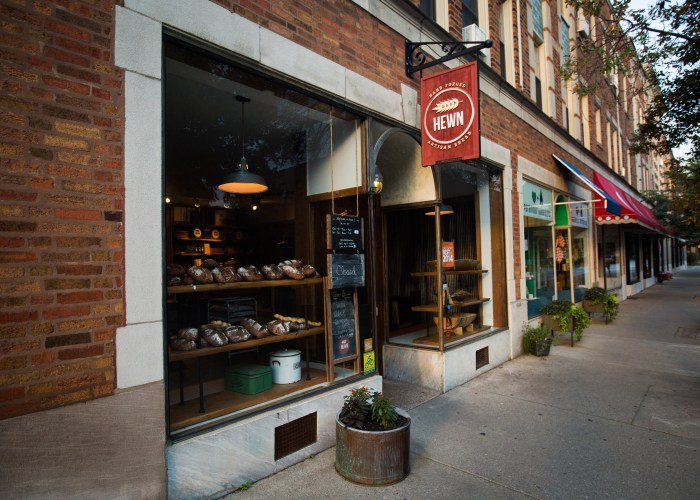Last Saturday’s demo was short and sweet. That was partly because of the continuous low-grade annoyance of light rain, but mostly because Ellen King’s flatbread was so darned delicious. In fact, nobody got a photo for this article because all the flatbread kinda vanished!
We all expected the bread to be both hearty and ethereal (!), but the topping, sourced from around the market, was equally divine. Here’s her recipe:
Ellen King’s Flatbread
Every Friday, we make flatbread at the bakery. It is fun to use our country bread dough in a different way, and it allows us to be more creative with savory ingredients. Depending on the season, we rotate our flatbreads each week to match the vegetables that are available. In summer, for example, when tomatoes are in season, we always make a Margherita-style flatbread. But you can add any toppings you want, such as chopped peppers, roasted garlic and goat cheese, or cooked beets with Parmesan and blue cheese or pesto—just cook until the toppings are bubbly. Our flatbread dough holds up really well in the oven, but make sure to brush it with olive oil before adding any topping to protect it from burning. A little oil also helps crisp up the crust. You will need a pizza peel and pizza stone.
*We sell the heritage flours recommended for this recipe at the bakery. We encourage you to purchase the vegetables and other ingredients needed for the flatbreads at your local Farmers Market. Also, note that this recipe requires the use of a starter and Country dough. Recipes for making both are found in the Heritage Baking cookbook, by Ellen King, published by Chronicle Books, 2018.
Ingredients
Dough
- 500 g water (76°F to 78°F [24.5°C to 25.5°C]), plus 30 g as needed
- 135 g starter
- 510 g sifted heritage flour (HRW/HRS), such as Glenn
- 200 g heritage whole-wheat flour (HRW/HRS), such as Rouge de Bordeaux or Turkey Red
- 14 g fine sea salt
Flatbread
- 75 g (¼ cup) coarse-milled heritage cornmeal (polenta)
- 50 g (¼ cup) olive oil
- 1 g (¼ tsp) fine sea salt
- 1 g (¼ tsp) freshly ground black pepper
- 10 g (1 Tbsp) coarse cornmeal
- 2 heirloom tomatoes, thinly sliced (optional)
- 1 cup shredded fresh mozzarella (optional)
- Sliced fresh basil, for garnish (optional)
Method
Use 1 recipe leftover Country Bread dough, or start the process to make that dough. Feed and rest your starter. Once the starter is ready, set a large bowl on the scale. Weigh out 500 g of water. Measure the reserve water and set aside. Return the bowl of water to the scale and tare the scale to zero. Add the starter and, using your hand, dissolve it gently in the water. Tare the scale to zero again. Add the sifted and whole-wheat flours. Using your hands and a bowl scraper, gently mix until all the flour is just a little wet.
If the dough is shaggy and dry, add more water from your extra stash by dipping your hands in the water and continuing to mix until it is slightly sticky. Cover with cheesecloth or a linen napkin and let rest for 40 minutes. Working in batches, drizzle 6 grams of salt over the top of the dough. Moisten hands by dipping them in your reserve water stash and slowly massage the dough until the salt granules have dissolved into the mixture. Use a bowl scraper to fold the dough over and onto itself. Add 6 grams of salt, mixing until dissolved. Add the remaining salt and mix until dissolved completely, dipping your hands in the water as needed.
Transfer the dough from the bowl to a shallow plastic container, cover loosely with cheesecloth or a linen napkin, and let sit for 30 minutes in a warm place. Use your hands to dig down and reach the bottom of the dough. Gently lift and pull (don’t tear) the dough and fold it over itself. Work each side like this until the dough has been lifted and folded 4 times. Let sit, loosely covered, for 30 minutes. Repeat the process for a second, third, fourth, and fifth turn and let sit, covered, for 30 minutes after each turn. Perform the sixth turn and let sit, covered, for 30 minutes.
Place a pizza stone in the oven and preheat the oven to 475°F [240°C].
Meanwhile, shape the flatbread. Divide into two balls. Take one of the dough balls and use a rolling pin to roll into an oval that’s 1/2 in [12 mm] thick. Refrigerate or freeze the remaining dough ball for future use, or shape and bake it after baking the first flatbread.
Continue to roll out the dough until the oval is about 14 by 10 in [35.5 by 25 cm]. Sprinkle a wooden or steel pizza peel or the bottom of a rimmed baking sheet with coarse cornmeal; this will help the dough slide onto a pizza stone. Place the rolled out dough on the pizza peel or the bottom of a baking sheet.
Brush with dough with olive oil and sprinkle with the salt and pepper. Lay the tomatoes over the dough and sprinkle with the mozzarella (if using). Carefully slide the dough onto the pizza stone.
Bake for 10 minutes, or until bottom is just set. Rotate and bake 5 minutes more, or until the crust is golden and the cheese is bubbly. Sprinkle with basil (if using). Cut into wedges (or other slices) and serve immediately.
Reprinted from Heritage Baking by Ellen King, with permission from Chronicle Books, 2018




